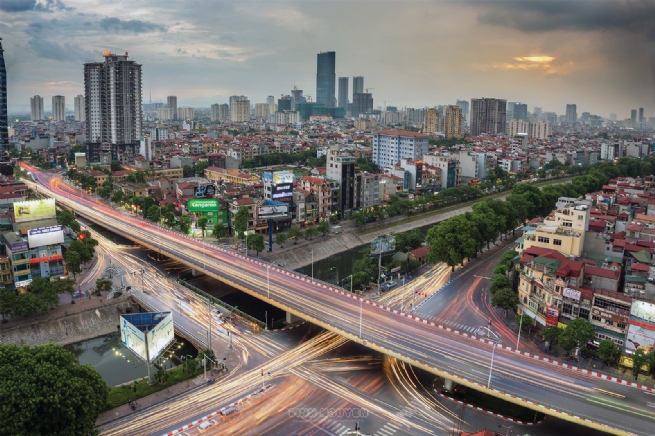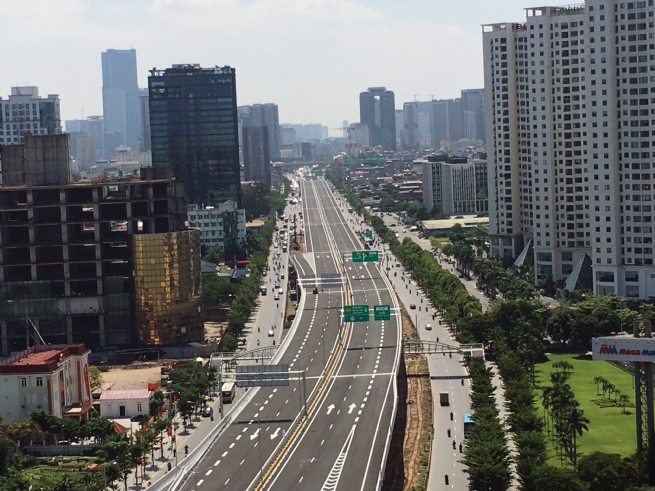2:20:15 PM | 6/19/2025
With proactive, creative, and innovative thinking, along with the tireless efforts of Party committees and authorities at all levels, and the solidarity and consensus of the people, the National Target Program on New Rural Development has, over time, transformed the city’s rural areas. Many improvements have been made, people’s lives have steadily improved, and prosperity can be seen in every household.

Hanoi’s infrastructure development not only enhances quality of life but also creates a favored environment for investors
However, as the construction of new rural areas progresses, it presents new requirements, demanding that localities continuously strive to enhance the quality of criteria, shifting the focus from "quantity" to "quality" in a sustainable, comprehensive, and in-depth manner.
Prioritizing infrastructure development
According to the Hanoi Coordination Office of the New Rural Development Program, 100% of the city’s communes and districts have now been recognized as meeting new rural standards. Among them, 229 out of 382 communes and 5 districts have achieved advanced new rural standards. If Thuong Tin district is approved, Hanoi will have 6 such districts, including Gia Lam, Dong Anh, Thanh Tri, Hoai Duc, Thanh Oai, and Thuong Tin.
Infrastructure development not only improves people’s lives but also creates an attractive environment for investors. According to Dang Thi Huyen, Chairwoman of Gia Lam District People’s Committee, when infrastructure is properly invested, large-scale urban areas such as Vinhomes Ocean Park, Dang Xa, and Trau Quy will be further developed, reshaping the local population and economic structure. As a result, industrial clusters like Phu Thi, Bat Trang, and Duong Xa have flourished, generating jobs for tens of thousands of rural workers with incomes higher than those from traditional agricultural production.
Thanks to the results of building advanced new rural areas, Hanoi’s socio-economic infrastructure has been developed in a coordinated, connected way between urban and rural areas. Transportation, schools, medical facilities, and cultural centers have been invested in, upgraded, and expanded to meet people’s needs, while both material and spiritual living standards have steadily improved. Nguyen Van Anh from Phu Dong commune, Gia Lam district, shared: “The advanced new rural program has greatly benefited our community. Especially, the upgraded inter-village roads have made travel much more convenient.”
Vice Chairman of Thuong Tin District People's Committee Bui Cong Than said: "At present, 100% of Thuong Tin communes meet new rural standards; 17 out of 28 communes meet advanced new rural standards, with 3 recognized as exemplary new rural communes. Thuong Tin has also fulfilled all 9 criteria for advanced new rural districts as set by the Prime Minister. The district has no outstanding debts in basic construction. Hanoi has submitted a proposal to the government for appraisal and recognition of Thuong Tin as an advanced new-style rural district in 2024."
These results not only help Hanoi meet the targets of Program No. 04-CTr/TU by the Hanoi Party Committee on "Promoting the effective implementation of the National Target Program on New Rural Development associated with agricultural restructuring and rural economic development, improving farmers’ material and spiritual lives for 2021–2025" but also contribute to raising farmers’ living standards.
Ngo Van Ngon, Deputy Director of the Hanoi Coordination Office of the New Rural Development Program, added that Hanoi has guided localities to build new-style rural areas closely aligned with future urban development. Some districts are carrying out new rural projects alongside plans for district-level urbanization, ensuring criteria for both are implemented in a scientific, systematic, and effective manner.
Hanoi’s policy is to continue investing in the strong development of inter-regional transport systems, ring roads, water supply and drainage, and waste treatment, while encouraging localities to actively attract businesses and cooperatives to join in developing infrastructure and services in rural areas. With synchronized infrastructure investment, the gap between rural and urban areas will gradually narrow. Suburban residents will enjoy modern living conditions while preserving the traditional cultural values that define the capital’s countryside. In 2024, the city’s average per capita income reached nearly VND75 million per year, and Hanoi has no poor households, Mr. Ngon added.


Hanoi is steadily advancing toward a modern city with rural areas as a growth pillar
Sustainable journey
From the beginning of building advanced new-style rural areas, Hanoi clearly defined this as not only a process of upgrading infrastructure and improving material life but also a journey toward sustainable development closely linked with culture, environment, and community governance. Alongside improving infrastructure, localities have focused on environmental protection, cultural preservation, security, order, and promoting digital transformation.
However, despite positive results, the process still shows disparities between areas. Some districts like My Duc, Ba Vi, and Ung Hoa continue to face difficulties in mobilizing resources, especially investment for technical and social infrastructure. Several advanced criteria, including environment, digital transformation, and market-linked production organization, remain slow to implement.
According to Director of Hanoi Department of Agriculture and Rural Development Nguyen Xuan Dai, to create momentum for sustainable development, Hanoi promotes decentralization, empowers commune-level authorities, and strengthens the monitoring and evaluation of the actual quality of advanced criteria. "Building advanced new rural areas is not only about meeting targets but about improving people's quality of life, creating livable rural communities, and ensuring sustainable development," Mr. Nguyen Xuan Dai emphasized.
With the active participation of the entire political system, the consensus of the people, and the support of the business community, Hanoi is steadily advancing toward the goal of becoming a modern urban area, with rural regions remaining a pillar of sustainable development, contributing positively to the growth of the thousand-year-old capital.
By Bao Ngoc, Vietnam Business Forum
| This special section is supported by Hanoi Coordination Office of the New Rural Development Program |